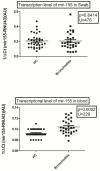Peripheral Blood and Nasopharyngeal Swab MiRNA-155 Expression in Infants with Respiratory Syncytial Virus Infection
- PMID: 37632011
- PMCID: PMC10459845
- DOI: 10.3390/v15081668
Peripheral Blood and Nasopharyngeal Swab MiRNA-155 Expression in Infants with Respiratory Syncytial Virus Infection
Abstract
Introduction: MicroRNA (miR) 155 has been implicated in the regulation of innate and adaptive immunity as well as antiviral responses, but its role during respiratory syncytial virus (RSV) infections is not known. The objective of this study was to investigate the expression of miR-155 using pharyngeal swabs and peripheral blood in infants with RSV infection and uninfected controls.
Methods: A prospective age-matched study was conducted in primary care in Torino from 1 August 2018 to 31 January 2020. We enrolled 66 subjects, 29 of them patients with RSV infection and 37 age-matched uninfected controls, and collected pharyngeal swabs and peripheral blood in order to assess miR-155 expression with real-time stem-loop-TaqMan real-time PCR.
Results: The data show that there is no correlation between pharyngeal swabs and peripheral blood with respect to miR-155 expression. The 1/ΔCq miR-155 expression levels in throat swabs in RSV bronchiolitis patients and healthy controls were 0.19 ± 0.11 and 0.21 ± 0.09, respectively, and were not significantly different between healthy controls and bronchiolitis (p = 0.8414). In the peripheral blood, miR-155 levels were higher than those of healthy control subjects: 0.1 ± 0.013 and 0.09 ± 0.0007, respectively; p = 0.0002.
Discussion: Our data provide evidence that miR-155 expression is higher in peripheral blood during RSV infection but not in swabs. This difference in the timing of sample recruitment could explain the differences obtained in the results; miR-155 activation is probably only assessable in the very early stages of infection in the swab and remains visible for longer in the blood. New investigations are needed in order to clarify whether the miR-155 expression in swabs can be influenced by different stages of virus disease of infants.
Keywords: RSV; antiviral immunity; bronchiolitis; miR-155; miRNA isolation; real-time PCR; swab.
Conflict of interest statement
The authors declare no conflict of interest.
Figures


Similar articles
-
Nasopharyngeal and Peripheral Blood Type II Interferon Signature Evaluation in Infants during Respiratory Syncytial Virus Infection.Medicina (Kaunas). 2024 Feb 2;60(2):259. doi: 10.3390/medicina60020259. Medicina (Kaunas). 2024. PMID: 38399546 Free PMC article.
-
Midturbinate Swabs Are Comparable to Nasopharyngeal Swabs for Quantitative Detection of Respiratory Syncytial Virus in Infants.J Pediatric Infect Dis Soc. 2019 Dec 27;8(6):554-558. doi: 10.1093/jpids/piy115. J Pediatric Infect Dis Soc. 2019. PMID: 30462262
-
Assessment of interferon gamma and indoleamine 2,3-dioxygenase 1 analysis during respiratory syncytial virus infection in infants in Italy: an observational case-control study.BMJ Open. 2022 Feb 28;12(2):e053323. doi: 10.1136/bmjopen-2021-053323. BMJ Open. 2022. PMID: 35228282 Free PMC article.
-
Mucosal Immune Responses to Respiratory Syncytial Virus.Cells. 2022 Mar 29;11(7):1153. doi: 10.3390/cells11071153. Cells. 2022. PMID: 35406717 Free PMC article. Review.
-
Relationship between respiratory syncytial virus bronchiolitis and future obstructive airway diseases.Eur Respir J. 2001 Dec;18(6):1044-58. doi: 10.1183/09031936.01.00254101. Eur Respir J. 2001. PMID: 11829086 Review.
Cited by
-
Potential of miR-192-5p as a diagnostic marker for children with severe pneumonia and respiratory failure and its predictive value for prognosis.Cent Eur J Immunol. 2025;50(1):98-104. doi: 10.5114/ceji.2025.149249. Epub 2025 Apr 9. Cent Eur J Immunol. 2025. PMID: 40620650 Free PMC article.
References
-
- Shi T., McAllister D.A., O’Brien K.L., Simoes E.A.F., Madhi S.A., Gessner B.D., Polack F.P., Balsells E., Acacio S., Aguayo C., et al. Global, regional, and national disease burden estimates of acute lower respiratory infections due to respiratory syncytial virus in young children in 2015: A systematic review and modelling study. Lancet. 2017;390:946–958. doi: 10.1016/S0140-6736(17)30938-8. - DOI - PMC - PubMed
-
- Shi T., Vennard S., Mahdy S., Nair H., RESCEU Investigators Risk Factors for Poor Outcome or Death in Young Children with Respiratory Syncytial Virus-Associated Acute Lower Respiratory Tract Infection: A Systematic Review and Meta-Analysis. J. Infect. Dis. 2022;226((Suppl. S1)):S10–S16. doi: 10.1093/infdis/jiaa751. - DOI - PubMed
MeSH terms
Substances
LinkOut - more resources
Full Text Sources
Medical

